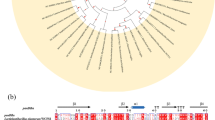Abstract
β-Alanine is an important precursor for the production of food additives, pharmaceuticals, and nitrogen-containing chemicals. Compared with the conventional chemical routes for β-alanine production, the biocatalytic routes using l-aspartate-α-decarboxylase (ADC) are more attractive when energy and environment are concerned. However, ADC’s poorly understood properties and its inherent mechanism-based inactivation significantly limited the application of this enzyme. In this study, three genes encoding the ADC enzymes from Escherichia coli, Corynebacterium glutamicum, and Bacillus subtilis were overexpressed in E. coli. Their properties including specific activity, thermostability, and mechanism-based inactivation were characterized. The ADC enzyme from B. subtilis, which had higher specific activity and thermostability than the others, was selected for further study. In order to improve its activity and relieve its mechanism-based inactivation by molecular engineering so as to improve its catalytic stability, a high-throughput fluorometric assay of β-alanine was developed. From a library of 4000 mutated enzymes, two variants with 18–22% higher specific activity and 29–64% higher catalytic stability were obtained. The best variant showed 50% higher β-alanine production than the wild type after 8 h of conversion of l-aspartate, showing great potential for industrial biocatalytic production of β-alanine.





Similar content being viewed by others
References
Anton DL, Kutny R (1987) Mechanism of substrate inactivation of Escherichia coli S-adenosylmethionine decarboxylase. Biochemistry 26:6444–6447
Carlson GH, Pearl River NY (1943) Preparation of beta-alanine. US Patent 2336067
Carter JL, Bekhouche M, Noiriel A, Blum LJ, Doumeche B (2014) Directed evolution of a formate dehydrogenase for increased tolerance to ionic liquids reveals a new site for increasing the stability. Chembiochem 15:2710–2718
Diaz E, Anton DL (1991) Alkylation of an active-site cysteinyl residue during substrate-dependent inactivation of Escherichia coli S-adenosylmethionine decarboxylase. Biochemistry 30:4078–4081
Ford JH (1945) The alkaline hydrolysis of β-aminopropionitrile. J Am Chem Soc 67:876–877
Fouad WM, Altpeter F (2009) Transplastomic expression of bacterial L-aspartate-alpha-decarboxylase enhances photosynthesis and biomass production in response to high temperature stress. Transgenic Res 18:707–718
Könst PM, Franssen MCR, Scott EL, Sanders JPM (2009) A study on the applicability of L-aspartate α-decarboxylase in the biobased production of nitrogen containing chemicals. Green Chem 11:1646–1652
Lee BI, Suh SW (2004) Crystal structure of the schiff base intermediate prior to decarboxylation in the catalytic cycle of aspartate α-decarboxylase. J Mol Biol 340:1–7
Li YF, Hess S, Pannell LK, White Tabor C, Tabor H (2001) In vivo mechanism-based inactivation of S-adenosylmethionine decarboxylases from Escherichia coli, Salmonella typhimurium, and Saccharomyces cerevisiae. Proc Natl Acad Sci U S A 98:10578–10583
Medici R, de Maria PD, Otten LG, Straathof AJJ (2011) A high-throughput screening assay for amino acid decarboxylase activity. Adv Synth Catal 353:2369–2376
Nozaki S, Webb ME, Niki H (2012) An activator for pyruvoyl-dependent L-aspartate α-decarboxylase is conserved in a small group of the γ-proteobacteria including Escherichia coli. Microbiology 1:298–310
Ohara T, Sato T, Shimizu N, Prescher G, Schwind H, Weiberg O, Marten K, Greim H (2011) Acrylic acid and derivatives. In: Ullmann’s encyclopedia of industrial chemistry. doi:10.1002/14356007.a01_161.pub2
Ramjee MK, Genschel U, Abell C, Smith AG (1997) Escherichia coli L-aspartate-α-decarboxylase: preprotein processing and observation of reaction intermediates by electrospray mass spectrometry. Biochem J 323:661–669
Saldanha SA, Birch LM, Webb ME, Nabbs BK, von Delft F, Smith AG, Abell C (2001) Identification of Tyr58 as the proton donor in the aspartate-α-decarboxylase reaction. Chem Commun 1760–1761
Sale C, Saunders B, Harris RC (2010) Effect of β-alanine supplementation on muscle carnosine concentrations and exercise performance. Amino Acids 39:321–333
Shen Y, Zhao L, Li Y, Zhang L, Shi G (2014) Synthesis of β-alanine from L-aspartate using L-aspartate-α-decarboxylase from Corynebacterium glutamicum. Biotechnol Lett 36:1681–1686
Song CW, Lee J, Ko YS, Lee SY (2015) Metabolic engineering of Escherichia coli for the production of 3-aminopropionic acid. Metab Eng 30:121–129
Uesugi H (1974) Process for production of beta-alanine. US Patent 3846489
Acknowledgments
This work was supported by the Science and Technology Service Network Initiative of CAS (KFJ-SW-STS-164), the Youth Innovation Promotion Association of CAS, and the CAS/SAFEA International Partnership Program for Creative Research Teams.
Author information
Authors and Affiliations
Corresponding authors
Ethics declarations
Conflict of interest
The authors declare that they have no competing interests.
Ethical statement
This article does not contain any studies with human participants or animals performed by any of the authors.
Electronic supplementary material
ESM 1
(PDF 187 kb).
Rights and permissions
About this article
Cite this article
Pei, W., Zhang, J., Deng, S. et al. Molecular engineering of l-aspartate-α-decarboxylase for improved activity and catalytic stability. Appl Microbiol Biotechnol 101, 6015–6021 (2017). https://doi.org/10.1007/s00253-017-8337-y
Received:
Revised:
Accepted:
Published:
Issue Date:
DOI: https://doi.org/10.1007/s00253-017-8337-y




